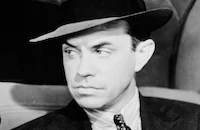Three Russian Girls
Cast & Crew
Fedor Ozep
Anna Sten
Kent Smith
Mimi Forsythe
Alexander Granach
Cathy Frye
Film Details
Technical Specs

Synopsis
In Leningrad in 1941, columns of infantry men and truckloads of soldiers stream into the streets, readying to defend the city against the Nazis. When Red Cross headquarters calls all volunteer nurses to duty, a group of twenty girls reports to receive uniforms and equipment. Among the group is Natasha, their leader; Tamara, a former dancer; and Chijik, their youngest member, a mere child. At the railroad station, Natasha bids goodbye to Sergei Korovin, her fiancé and a soldier in the Russian army. The next morning, the Red Cross trucks deliver the nurses to the battlefront, where the field doctor orders them to convert an old wooden mansion into a hospital. That evening, a transport of wounded soldiers arrives, bringing the nurses their first taste of the bloody realities of war. Later, when a Russian plane is downed by Messerschmidts near the hospital, John Hill, an American flyer who had been testing the aircraft, is brought to the facility. Although an operation saves John's life, his legs remain numb from the shock. Despondent, John blames himself for the death of the plane's pilot. Natasha cares for John day and night, and he slowly recovers the will to live and discovers that he has fallen in love with her. When the enemy nears the hospital area, an order to evacuate is given and the nurses carry the wounded to waiting ambulances. After enemy artillery destroys a section of the hospital and one of the ambulances, some of the patients are forced to wait behind until an new ambulance can be dispatched. Natasha volunteers to stay behind with John and several of the other wounded men, and they all take cover in a dugout. That night, John confides his dream of seeing his country again once the war ends. The next day, Natasha and the others are rescued and driven to another hospital far removed from the front. There John recovers and begins to walk again, and although Natasha has fallen in love with him, she goes without hesitation when a call comes from the front for five more nurses. Deciding to tell John about her fiancé before she leaves, Natasha approaches him but is stopped by a wounded soldier asking for water. When the soldier tells her that Sergei was killed in battle, Natasha, speechless, wanders away without speaking to John. Natasha performs bravely at the front, and when a blizzard strikes, she forms a ski patrol to reach the injured. After Natasha is wounded in battle, she is taken to a hospital in Leningrad. Soon after, John receives orders to return to the United States. Before leaving, he seeks out Natasha at the hospital and, without declaring his love, bids her farewell and assures her that they will meet again once victory over Germany is declared.

Cast
Anna Sten

Kent Smith
Mimi Forsythe

Alexander Granach
Cathy Frye

Paul Guilfoyle
Kane Richmond
Manart Kippen
Jack Gardner
Marcia Lenack
Mary Herriot
Anna Marie Stewart
Dorothy Gray
Feodor Chaliapin
Crew
Maurice Clark
Stanley Cowan
Joseph Depew
Eugene Frenke
W. Franke Harling
W. Franke Harling
Carley Harriman
Frank Hills
Dan James
Aben Kandel
Ted Larsen
Eugene Lourie
William Lynch
John Mescall
Gregor Rabinovitch
Gregor Rabinovitch
Gregory Stone
Frank Sylos
Irving Talbot
Gregg Tallas
Glenn P. Thompson
Victor Trivas
S. K. Winston

Film Details
Technical Specs

Award Nominations
Best Score
Quotes
Trivia
Notes
The working title of this film was The Girl from Leningrad, which was also the title of the Artkino production, starring Zoya Fyodorova, on which the film's story was based. Pre-production Hollywood Reporter news items yield the following information about the production: In September 1942, M-G-M was negotiating to buy the rights to the Russian film from Gregory Rabinovich and Eugene Frenke. At that time, Michele Morgan and Greta Garbo were considered for the leads and Gregory Ratoff was mentioned as director. A week later, Frenke decided to produce the film himself and so withdrew from negotiations with M-G-M. At that time, Igor Vushenko and E. Stork were announced as screenwriters, but the extent of their contribution to the released film has not been determined. Although a December 1942 news item noted that Rabinovich was withdrawing from the production of the film and would retain only a financial interest, this May have not been the final case as he was credited onscreen as producer.
In January 1943, Maria Manton, Akim Tamiroff, Leonid Kinskey, Tamara Shayne, E. Grusskin, Melva Doney and Diane Duval were announced as members of the cast, but their appearance in the released film has not been confirmed. In another Hollywood Reporter news item, Doney's name was written as "Zona Doney" and Duval's was written as "Diana Duvall." In May 1943, producer Gregor Rabinovitch was reportedly seeking Luise Rainer to play the starring role. Mimi Forsaythe replaced Oona O'Neill Chaplin as "Tamara" and Manart Kippen replaced Leo Bulgakov as "Misha" in July 1943. A July 26, 1943 news item adds Patty Pope to the cast, but her appearance in the released film has not been confirmed. Another late July 1943 news item noted that Artkino provided Rabinovitch with 500,000 feet of actual battle scenes filmed on the war front by Soviet cameramen. According to the Hollywood Reporter review, the battle scenes and ski sequences in this film were excerpted from the Artkino film The Girl from Leningrad. The picture was nominated for an Academy Award for Best Score. The titles of songs included in the film have not been determined.












